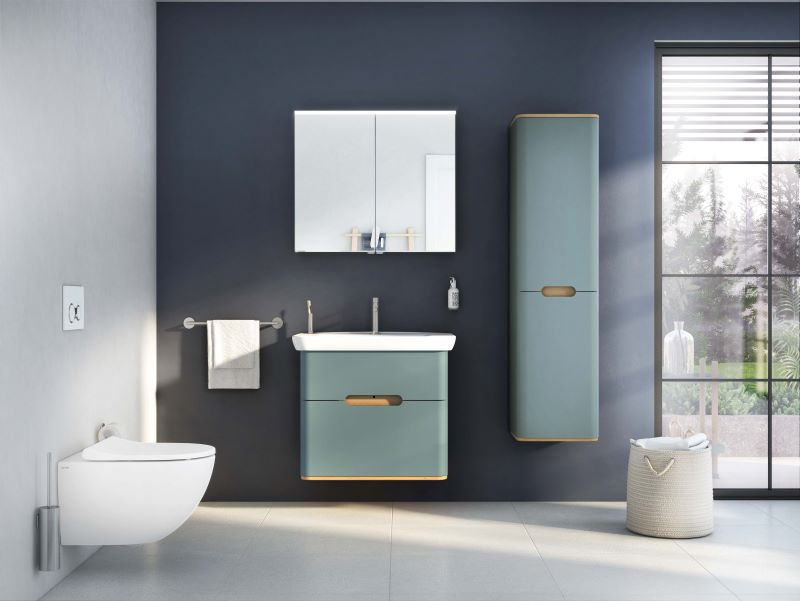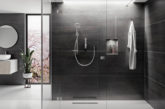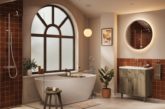
Being a bathroom installer frequently entails more than the fitting. Space planning and interior design skills as well as knowledge of all the latest bathroom product developments and trends all spring to mind. To support installers, Ruth Davies, Senior Marketing Manager from VitrA, offers up relevant and current responses to some of the common questions installers get asked.
Q. I’ve got a tiny bathroom; how do I optimise the space?
Although UK building regulations don’t detail the exact size requirements, recommended minimum clearances around fittings allow for comfortable circulation and particular products can help where space is at a premium.
Compact washbasin, toilet and vanity unit options with shorter projections can be used to optimise space. For example, the depth of an average washbasin is 450mm, whereas the VitrA Integra Compact Washbasin is just 220mm, offering a installers a neat solution. A semi-recessed basin also works well in a smaller bathroom, still providing counter space for everyday items.
Point customers towards units with double doors, so they project less into the room when opened and get them thinking about whether single doors need to be right- or left-handed to maximise space.
Wall-mounted or ‘floating’ options, like wall-hung basins, toilets and washbasin vanity units, that incorporate storage such as those in VitrA’s Sento Collection, offer customers a sense of space by not cluttering the bathroom floor. Although this approach requires structural planning, which can eat into the floor area, if thoughtfully planned, recessed niches can add handy spaces for added organisation or decoration. Tall and short units can incorporate flexible options from shelving to integrated laundry baskets as well as recessed niches for open storage. There are even compact versions for especially tight spaces.
Q. How can I reduce my water usage?
With the average person using 143 litres per day and 63% of that used in the bathroom (according to waterwise.org.uk), there are various recommendations for water-saving opportunities.
Introducing customers to a low-flow product such as a tap with a water aerator is one option. This adds streams of air into the water flow, allowing less water to be used, whilst still maintaining the pressure. Many manufacturers offer integrated aerators in their taps for added convenience.
Another opportunity is the toilet. On average, a toilet is flushed 7.7 times a day per person and is one the main culprits for water waste. However, with a dual flush, users can choose a smaller flush, which can use as little as 2.5-4 litres of water.
If your customer is looking for a shower, thermostatic showers may be a more environmentally friendly option, they’re also a cost-efficient and safe choice for those living with young children or older people. By carefully mixing hot and cold water and recognising changes to the water pressure, both water and energy consumption are reduced.
VitrA adds two new frame and concealed cistern models to its portfolio
Q. How can I make the bathroom safe for my frail partner without making it feel institutionalised?
For customers facing mobility issues and frailty, safety is crucial. One suggestion is to install grab bars in strategic locations such as near the toilet and shower to provide stability and support.
Thankfully, in today’s market, it’s possible to seek out manufacturers that design with accessibility, inclusivity and practicality in mind from the outset. A comfort height toilet can be beneficial for people with reduced mobility. These are taller than standard size toilets but look the same, reducing the distance for the user to bend to sit down and stand up.
You could also suggest a shower toilet (sometimes called a bidet toilet, a washlet or an automatic wash dry toilet). This type of toilet combines the functionality of a toilet with the cleaning properties of a bidet. By washing with water, it is ideal for people with reduced mobility and models that include a dryer function eliminate the need for toilet paper and wiping, to offer a completely hands-free experience.
Q. I love ‘techie’ things, what smart things can I include in my bathroom?
There are a number of products that tech savvy clients will appreciate. A smart shower toilet controlled via a remote control or an app can really appeal to the gadget minded. Choose from models that feature enhanced technology such as motion sensor night lights; motion sensor toilet seats which automatically lift and close when the occupant walks in and out of the bathroom; heated seats and integrated dryers.
For concealed cisterns, a smart flush panel which can be controlled by voice or mobile app means the customer can flush their toilet remotely or automatically after use. An example is VitrA’s Smart Panel Flush Plate which, when connected to the compatible app, allows the user to flush and view usage data for their toilet remotely. It also provides weekly water usage reports to help households to identify how they can be more water-efficient.
Q. What haven’t I thought about in my bathroom design that you think I should include?
It’s the finishing touches that can make a difference: the waste set for the basin, the overflow cover to match the tap and a soft closing toilet seat.
Practical accessories from soap dispensers, bathrobe and towel holders to accommodating toothbrushes, toilet rolls and toilet brushes can all be specified with the same colour and finish to provide a cohesive look.
Lighting can add practical points of interest too. LED light accents add to the ambiance of the space while being a functional enhancement for a mirror.
Just because a bathroom may not have a large area it doesn’t mean that style, comfort and functionality have to be compromised. In fact, with so many choices available it’s quite the opposite nowadays, it’s simply a case of guiding customers to ‘smart’ space solutions in every sense of the word.













